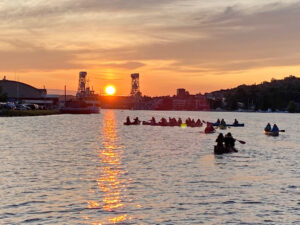 Freshwater has been awarded $1.5 million from the Great Lakes Protection Fund for a 5-year effort to improve water quality in the Maumee, St. Louis and Saginaw River watersheds, tributaries to the most impaired areas of the Great Lakes.
Freshwater has been awarded $1.5 million from the Great Lakes Protection Fund for a 5-year effort to improve water quality in the Maumee, St. Louis and Saginaw River watersheds, tributaries to the most impaired areas of the Great Lakes.
The project team will use cause marketing to raise funds for permanently converting marginal cropland to perennial vegetation, thereby enhancing carbon storage and curbing nutrient runoff.
According to Carrie Jennings, Freshwater research and policy director who is leading the project, “There are many geologic, economic and societal commonalities across the Great Lakes states that allow us to expand the geographic reach of our efforts to improve water quality. We are grateful for the support and guidance of the Great Lakes Protection Fund, the enthusiasm of our new land trust partners, and the fiscal-management help of The Conservation Fund, Great Lakes Office.”
Permanent solutions on carefully selected croplands
Working with local land trusts and watershed modeling experts, the team will identify landowners in key locations and prioritize croplands that would provide the greatest water quality benefits. This science-based approach will be used to carefully select parcels, helping the land trusts build capacity and expertise in the process.

The team will develop a modeling framework to target areas with the highest potential for phosphorous loading, along with the lowest predicted land value, in order to maximize the overall return on investment and make sure funds are put to good use.
In contrast to other programs that rely on landowners to voluntarily install best practices, this approach provides a permanent solution that benefits water quality, soil health and wildlife habitat. Even Conservation Reserve Program (CRP) contracts, which pay farmers to take acres out of production, are not permanent – and the number of enrolled acres can fluctuate significantly from year to year.
Cause marketing for conservation
To fund land acquisitions and conservation easements, the project will include a cause marketing campaign led by the Bolin-Zwieg Agency. The goal will be to partner with several large brands that can engage consumers in point-of-sale donations and other promotions.
By building a memorable and engaging brand around this project, the team is confident that consumers will support Great Lakes water quality efforts through their donations.
“Conservation funding is complex, competitive, and always evolving,” said Zachary Branigan, executive director of the Saginaw Basin Land Conservancy. “We are grateful for the opportunity to help develop a new way to generate dollars for land protection, directly from customers who make market choices to do so. We believe that cause marketing will be a strong asset to the land trust community and can empower our organization to take on critical conservation projects.”